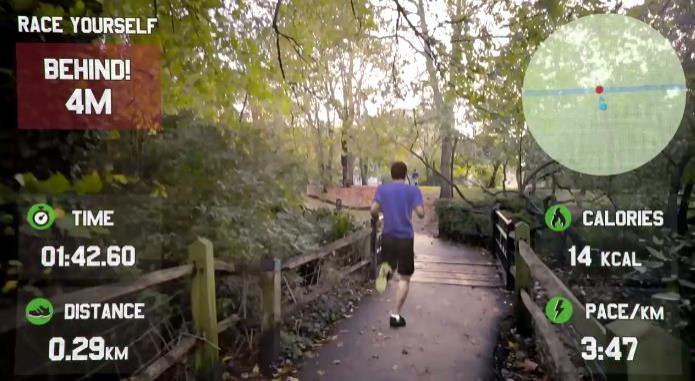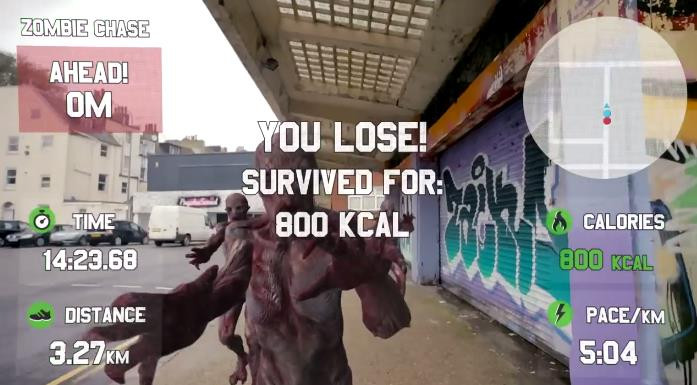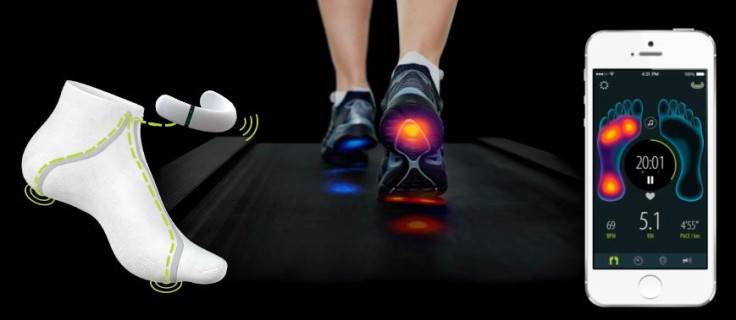Ghost Replays, Zombies & Runaway Trains: Race Yourself for Google Glass Makes Exercise Fun
Three Londoners in their early 20s knew immediately what their contribution to an industry-defining product would be - a running app blending serious fitness tracking and racing your friends, with earning points by fleeing from zombies.
Using Google Glass is a strange experience. Once you get over the utterly alien concept of attaching a heads-up display to your face, there isn't an awful lot to do. You can take photos, perform a Google search and take phone calls, but the battery can be killed in less than an hour and the user interface is incredibly basic.
To use an industry buzzword, Glass needs 'killer apps' which prove Glass has a point and a purpose beyond being unusual - and the team behind Race Yourself believe they have exactly that.
Ghost replays

Anyone who's played a racing game will be familiar with the ghost replay; a semi-transparent visualisation of your previous best time acting as a marker for you to beat. That's essentially what Race Yourself is - a Google Glass application which can record the wearer's running, cycling, snowboarding and even sky diving, and play back their fastest time as a target to beat. The app can also work in the gym, where it uses its camera to understand rowing and press ups, amongst other activities.
Working from a free co-working space in Camden, North London, friends Richard Goodrum, Ben Gamble and Alex Foster hope Race Yourself will be a primary reason for technology and fitness fans alike to buy Glass when it goes on sale to the general public later this year.
A 'pretty risky' move away from a safe job
But getting to where they are now - with a fully working app, 11 employees, $300,000 (£180,000) in investment and celebrity athletes knocking on the door - has been much more than a jog in the park.
"It was pretty risky" Goodrum, 24, tells IBTimes UK, remembering the decision he and his fellow co-founders made to leave their high-paying jobs in pursuit of creating the first Google Glass exercise app.
The startup's operations officer continued: "Alex said 'I have this crazy idea' and sat down with Ben over Skype to talk about it. They threw the idea back and forth and it got stronger and stronger, until we thought 'this is going to be possible, Google Glass is going to open up so many possibilities. We want to be the first ones there'."
After six months of testing - mostly without direct access to Glass, due to Google's reluctance to sell the device to non-US developers - the team decided to push ahead, believing they could create a company.
$300,000 of venture capitalist investment was secured - again, mostly without access to Glass itself, as Goodrum recalls: "We had the app running on phones and tablets saying [to potential investors] 'this is what it's going to look like' and that was enough. I think they could see what we were pointing at and what the potential was."
The fear of not being first
With this money the team set to work, securing three Google Glass units and expanding their workforce to 11. Goodrum admits they took a "gung-ho" approach, hiring quickly in a bid to be first to market and ready for when a consumer version of Glass goes on sale - "towards the end of 2014," claims Google, although developers are braced for a summer launch.
"I think Alex and Ben were really conscious about missing out on the opportunity, or of not being the only ones out there [with a running app for Glass]. The fear of seeing someone else do it was the main motivating factor behind doing it."

Race Yourself is aimed as much at the serious athlete as it is the casual Glass user who wants to blend exercise with fun. As well as running or cycling against a ghost replay of yourself, users can flee from hoards of zombies, runaway trains or tumbling boulders displayed in a rear-view mirror on Glass' display - or augmented in full if the runner looks behind them.
Goodrum admits this element of gamification wasn't intended from the start, but having seen the huge success of Supercell, Candy Crush Saga and the freemium business model - where the app itself is free but additional content is charged for - the Race Yourself team saw how money could be made.
You don't have to be Mo Farah to unlock the best content
But unlike some freemium games, where desirable content - such as the fastest cars or most powerful weapons - are all but impossible to get without paying, Goodrum claims Race Yourself users "don't have to be Mo Farah" to unlock all of the app's content. "It's for the average runner so everything is achievable and unlockable."
Speaking of famous athletes, Goodrum revealed that an individual recently contacted the Race Yourself team to inquire about the app. Hoping to strike partnerships with famous athletes, Goodrum said: "There will be a section you can unlock where you can run against celebrities and athletes.
"You could have an avatar of the celebrity and they give you motivational tips, or where they are giving in-depth knowledge of their training routine...or you could aim at the more serious users and give them a training programme. We could then work off an affiliate model where users pay to unlock [the celebrity athletes]."
Striking a balance between appealing to both gamers who occasionally run and athletes who want to beat their personal best was an important aspect of the app's development - and while running from zombies will suit the gamer in all of us, the Race Yourself team want to keep serious users just as happy.
Smart socks

To satisfy the most demanding users Race Yourself has partnered with Sensoria, a manufacturer of smart socks capable of recording not just your steps while running, but also your technique and where on your foot you are applying the most pressure. The socks gather this data and feed advice back through Glass to the user, helping to perfect a better running style and prevent injury.
Beyond that, Race Yourself will be offering t-shirts and sports bras with integrated heart rate monitors which can also communicate with Glass; Goodrum suggests a mini-game where the runner must keep their heart rate up for a certain amount of time could be created.
The chicken-and-egg problem
When the first iPad was released I felt it had a chicken-and-egg problem. The device itself was hugely desirable - I know, I queued up and bought it on day one - but once the initial excitement had faded, a device with an undefined purpose was left behind.
Developers eventually created applications to take advantage of the hardware and now Apple is the proud owner of a huge, varied and high-quality catalogue of tablet apps.
For now, Google Glass has the same problem. The hardware is out-of-this-world and Google has to be commended for taking such an almighty gamble to get Glass as far as it has, but now it's down to the developers to make it worth buying, and applications like Race Yourself will make the difference between Glass disappearing into obscurity and it writing a new chapter in the history of consumer technology.
© Copyright IBTimes 2025. All rights reserved.






















